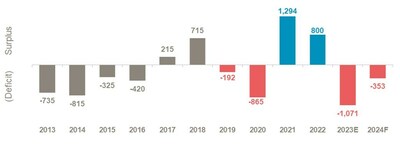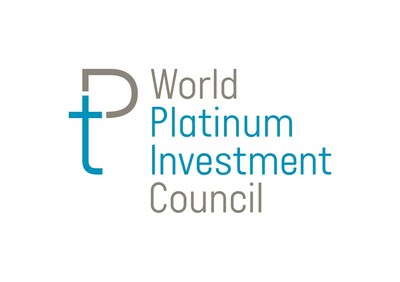- Platinum deficit of 353 koz forecast for 2024, with this year’s deficit to exceed 1 million ounces
- Both mining and recycling supply expected to be well below pre-COVID levels in 2023 and 2024
- Automotive demand continues to strengthen, up 14% this year, with a further 2% increase expected next year
- 2023 will see the highest industrial demand on record, with 2024 the third-highest
- Investment demand forecast to remain positive in 2024
LONDON, Nov. 21, 2023 /PRNewswire/ — The World Platinum Investment Council – WPIC® – today publishes its Platinum Quarterly for the third quarter of 2023, with revised estimates for 2023 and a first forecast for 2024.
The market is expected to reach a record deficit of 1,071 koz in 2023 as exceptionally strong year-on-year demand growth of 26% (+1,690 koz) to 8,150 koz far exceeds weaker supply, which is expected to drop 3% year-on-year to 7,079 koz.
In 2024, a second consecutive market deficit is forecast at 353 koz, with demand reducing by 6% (-487 koz) to 7,663 koz and total supply increasing by 3% (+231 koz) to 7,310 koz, still well below pre-COVID levels.
Supply constraints in mining and recycling persist
Global mine supply for full-year 2023 is expected to be essentially flat year-on-year at 5,608 koz, remaining around 8% below the 5-year pre-COVID average production level, which reflects some of the ongoing challenges the industry has been facing. Downside risks remain, such as a worsening of the electricity shortage in South Africa, but investment in processing infrastructure, as well as asset optimisation, has reduced the risks to mining.
For 2024, global platinum mine supply is forecast to grow by 3% (+191 koz) year-on-year to 5,743 koz, with a 5% improvement in South African output expected.
The global platinum recycling estimate for 2023 has been further downgraded to 1,471 koz, 13% lower than the already reduced levels of 2022, due primarily to a shortage of end-of-life vehicles as consumers are driving existing vehicles for longer and as scrappage yards accrue spent units in the face of weak PGM prices. These headwinds are expected to continue in 2024, meaning global recycling of platinum is expected to see only a modest improvement in 2024, increasing by 7% (+96 koz).
Automotive demand set to increase for fourth consecutive year in 2024
In 2023, automotive platinum demand is expected to jump by 14% to a six-year high of 3,262 koz, driven by an 8% increase in global light-duty vehicle production and a 10% rise in heavy-duty vehicle production. Stricter emissions regulations, particularly in China, have also driven demand. Furthermore, it is estimated that platinum-for-palladium substitution will reach around 620 koz this year, against 385 koz in 2022.
Growth is also anticipated in 2024, with automotive demand projected to rise by 2% year-on-year to 3,312 koz, its highest level since 2016. Tighter emissions legislation, along with a forecast increase in platinum-for-palladium substitution to around 700 koz, will drive continued growth across most regions.
Record industrial demand in 2023, followed by third highest year in 2024
Industrial demand for 2023 is predicted to surge by 14% year-on-year (+317 koz) reaching 2,652 koz – marking the strongest year on record. This growth has been propelled by significant capacity expansions in the glass sector (+50%, +251 koz) and the chemical sector (+10%, +68 koz), which offset lower demand from the electrical (-13%, -14 koz) and petroleum (-12%, -23 koz) markets.
While industrial demand is forecast to fall 11% in 2024, it will nevertheless be the third-highest level on record at 2,367 koz. Due to fewer capacity additions, platinum demand will decrease in the glass (-18%, -133 koz) and chemical (-22%, -168 koz) segments year-on-year. Conversely, the medical sector is forecast to experience a 3% increase in demand to 292 koz, driven by the expanded use of platinum in medical devices and cancer treatments, especially in emerging markets. Additionally, the ‘other’ industrial segment is projected to grow by 4% to 620 koz.
Platinum jewellery demand remains unchanged
Global jewellery demand in 2023 is anticipated to decline by 3% from the previous year to 1,852 koz, with increases in India and North America failing to counteract weakness elsewhere, especially in China. For 2024, demand is expected to increase by 3% to 1,903 koz, with gains in China and India expected to be offset by a weaker North American market.
Second consecutive year of positive net investment
Global retail investment in platinum is anticipated to climb by 36% to 305 koz in 2023, primarily driven by a positive turnaround in Japan after three years of net disinvestment. ETF holdings experienced inflows for the first nine months of the year amid South African power supply concerns. However, with anticipated outflows in the final quarter, annual holdings will level out to a modest 50 koz gain. Net investment for the full year is expected to be 385 koz.
Bar and coin investment for 2024 is projected to fall by 44% to 172 koz, with demand in North America decreasing by 11% and Japan returning to net disinvestment. Platinum ETFs are expected to see an outflow of 120 koz next year, affected by high interest rates in Europe and North America. Meanwhile, forecast inflows to exchange warehouses stand at 30 koz. The result will mean net positive investment of 82 koz for the year.
Trevor Raymond, CEO of the World Platinum Investment Council, commented:
“Following this year’s forecast record deficit, in excess of 1 Moz, the platinum market is now facing consecutive deficits. This demonstrates, somewhat counterintuitively, the resilience of the platinum market despite economic headwinds, a feature that is strongly linked to its diversity of demand. During 2023, platinum has benefited from stellar industrial demand to reach a record level, as well as a strong recovery in automotive production and, of most significance, ongoing growth in platinum-for-palladium substitution.
“The backdrop to next year’s second consecutive deficit anticipates further, albeit more moderate, automotive demand growth, while industrial demand, though lower year-on-year, remains robust and 22% higher than the 5-year pre-COVID average level.
“Meanwhile continuing challenges present downside risks to both mined and recycling supply into next year, not least as miners look to reassess production plans and restructure operations to manage the negative impact of the significant decrease in the PGM basket price on mining profitability.
“The economic aftershocks of the past three years are still being felt in the platinum market and continue to affect market behaviour and prices today. In the automotive sector, over 30 million fewer vehicles being produced between 2020 and 2022 resulted in automakers being able to soften regular buying and ease market tightness. During the recovery of the global vehicle market up until now, this excess PGM inventory has helped meet demand, which to an extent has helped meet market shortfalls. As these inventories diminish with continued growth in vehicle production and sales, we foresee a return to more typical automaker platinum buying patterns, which could further tighten the market and place upward pressure on the platinum price.
“Platinum remains an essential component in reducing harmful vehicle emissions and is already a crucial element in unlocking hydrogen’s role in the decarbonisation of transport and other industries. It is becoming increasingly recognised as key to the emerging hydrogen economy. Currently, platinum’s investment appeal lies in its considerable market deficit, but looking ahead, investors will also reap the benefits from a hydrogen-driven demand tailwind.”
Disclaimer
Neither the World Platinum Investment Council nor Metals Focus is authorised by any regulatory authority to give investment advice. Nothing within this document is intended or should be construed as investment advice or offering to sell or advising to buy any securities or financial instruments and appropriate professional advice should always be sought before making any investment. For further information, please visit www.platinuminvestment.com
Photo – https://mma.prnewswire.com/media/2282043/WPIC_image.jpg
Logo – https://mma.prnewswire.com/media/2201083/WPIC_Logo.jpg
![]() View original content to download multimedia:https://www.prnewswire.com/news-releases/wpic-second-consecutive-platinum-deficit-forecast-in-2024-amid-ongoing-automotive-and-industrial-demand-strength-and-constrained-supply-301994044.html
View original content to download multimedia:https://www.prnewswire.com/news-releases/wpic-second-consecutive-platinum-deficit-forecast-in-2024-amid-ongoing-automotive-and-industrial-demand-strength-and-constrained-supply-301994044.html
SOURCE World Platinum Investment Council (WPIC)

Featured image: DepositPhotos © gwhitton








